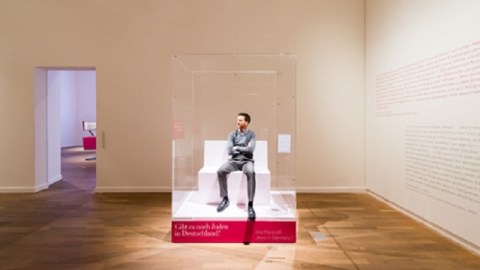Can an Art Exhibition Answer Germany’s Jewish Question?

The Holocaust is a touchy subject anywhere on earth, but touchiest at the capitol of the country where “The Final Solution” began. Germany and its capitol, Berlin, still struggle with the “Jewish question” not as the Nazis once did, but in terms of how to overcome the weight of all that tragic history and its lingering effect on its culture. Taking a lighter approach to this weighty subject, the Jewish Museum Berlin offers The Whole Truth … everything you always wanted to know about Jews. The Whole Truth tries to answer all the awkward questions in hopes of making being Jewish and German both less exotic and less an automatic mental connection to the death of 6 million people of a specific faith and ancestry. But, for all it’s good intentions, can an art exhibit really answer Germany’s Jewish question?
Whereas most art exhibitions announce that they “answer questions,” The Whole Truth actually provides opportunities to find answers to questions. “How does someone become a Jew? What am I, if my mother is Christian and my father is Jewish? What is the Jewish take on Jesus and Mohammed? Are the Jews a Chosen People?” are just some of the questions asked and answered in this exhibition through wall text and objects that humanize and normalize Jewish people in a German setting. The “game show”-sounding titled, life-sized “Ask a Rabbi” film installation allows visitors to listen to seven Germany-based rabbis representing the whole range of Judaism—orthodox, liberal, conservative, progressive—answer questions as everyday, but essential to understanding as “Can a person be Jewish without being circumcised?” or “Can a Jew ever stop being a Jew?”
The section that initially bothered me the most by title alone was “How do you recognize a Jew?” Such stereotypes instantly recalled the worst of the singling out of the Jewish people by the Nazis. Those ominous overtones, however, disappear thanks to such innovative and amusing installations such as the 70 Jewish hats display. By the end, you’ll know a shtreimel from a borsalino from a mitznefet from a kippot. My kids would love to wear the kippot (also known as a yarmulke) with the Angry Birds design, and I’ll bet most other non-Jewish kids would, too. The Whole Truth thus humorously and visually demonstrates the wide range of Jewish hatwear as a physical manifestation of their diverse (religious, ideological, and political) purposes, sometimes overt and sometimes covert.
The part of the exhibition that’s gained the most international attention is the “Jews in a Showcase” section, which has been indecorously called “Jew in a Box” by much of the American press. The premise is simple: a Jewish “guest” (Leeor Engländer, in the example shown above) takes a seat in the glass case and interacts with the patrons. The controversy stems from the idea that the “guest” is somehow unethically treated as a specimen for examination, like an animal in a zoo. But if the “guest” enters and leaves willingly and interacts with the audience as he or she wishes, the “zoo” analogy falls apart. The question posed and answered by this section is “Are there still Jews in Germany?” How better to answer that question than with an actual, live Jewish German?
The press release quotes journalist Richard C. Schneider commenting after the opening of the Jewish Museum Berlin in 2001 that, as a German Jew, he was already “a living exhibition object” for fellow non-Jewish Germans “who in their contact with me are encountering a Jew for the first time in their lives, [and] tend to react with confusion.” Schneider goes on to explain that, during such encounters, “[s]uddenly I am seen as in a showcase, as a rare example of a species under glass, which one does not actually know, but thinks one does.” “Jews in a Showcase” not only mimics the natural dynamic of German Jew/non-Jew encounters, but also makes that dynamic as transparent as the showcase itself and clarifies the power relationships inherent in the “confusion” by reversing the order and putting the Jewish person in control. “Jew in a Box,” therefore, is instead Jews thinking outside the box of limited interaction within their own society.
Just viewing the animated YouTube trailer to The Whole Truth will give you an accurate idea of the humor and warmth of this effort towards greater understanding. I found it fascinating that they include Superman, an essentially American but now international icon, in the film. Jewish-American teenagers Jerry Siegel and Joe Shuster created Superman in 1932 (and spent the next 6 years trying to sell him to a publisher) as a response to the Nazis’ adoption of Friedrich Nietzsche’s “Übermensch” as the “superman” of their master race. Over time, Superman’s Jewish roots went underground as he gained more mainstream popularity.
The Whole Truth … everything you always wanted to know about Jews, which runs through September 1, 2013, asks the question of where are the Jews, but, as in the case of Superman, the Jews have been with them and us all along, embedded in our cultural DNA the entire time. For those who might mentally add the Woody Allen-esque “but were afraid to ask” to the end of the exhibition’s title, there’s nothing to fear from The Whole Truth, which, even if only in a modest way, may help set Germany free from its racist past to live a more open, enlightened future.
[Image:Leeor Engländer in the Showcase. © Jüdisches Museum Berlin. Photograph: Linus Lintner.]
[Many thanks to the Jewish Museum Berlin for providing me with the image above and other press materials related to The Whole Truth … everything you always wanted to know about Jews, which runs through September 1, 2013.]





